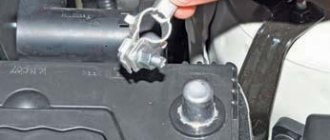When to charge the battery
The battery must be charged as it is charged. If the generator is in working order in the summer, you won’t have to do this at all. In the cold season, when the car is frequently idle or when traveling short distances, the battery will gradually begin to discharge.
In this case, before and after the trip, it is necessary to check the voltage at the terminals. If it drops to 12.2 V, then the battery is 50% discharged, and if it drops to 12 V, then it is almost completely discharged.
You can also use a hydrometer to check the condition. This is a device by which the density of the electrolyte in the batteries being serviced is measured. The hydrometer is used only for serviceable batteries. In unattended ones, it is not possible to unscrew the caps of cans of electrolyte and distilled water to measure the density.
The hydrometer probe is lowered into the container and the density in grams divided per cubic centimeter is displayed on the device screen. The figure should correspond to 1.27. If less, then charge the battery.
The third simple verification method is used in extreme cases. Based on turning on the ignition. If the car does not start or does so slowly and reluctantly the second time, then such errors indicate that the battery is discharged.
Features of maintenance and operation of calcium batteries
Since maintaining the charge at the proper level is of paramount importance for the correct operation and long-term operation of a calcium battery, motorists will find it useful to know what the features of using calcium batteries are and how it differs from the use of similar devices of other classes:
1. If a car with a calcium battery is operated in “city mode”, “preventative” charging will help maintain its performance. You can purchase a special device (a high-quality model is not cheap, but the costs are worth it) and fully charge the battery at least once every 4 weeks. Then long periods of downtime and movement over short distances will not affect its service life. In all other cases, the device will require recharging half as often;
2. It is recommended to charge a modern lead-calcium battery up to 14.4 V, while manufacturers indicate that a charge with a current of no higher than 1/10 of the declared capacity is required.
3. The voltage at the terminals should be measured regularly using a voltmeter. If the device shows 12V, the device needs to be charged immediately, otherwise it will be almost impossible to avoid loss of capacity;
4. A deep discharge causes an irreversible chemical reaction to occur in the plates, resulting in the formation of an insoluble residue in the form of calcium sulfate - such acidic deposits block the transfer of charge. Many motorists, out of habit, carry out CTC with a calcium battery, which has a detrimental effect on the battery;
5. “Boiling” calcium batteries is strictly contraindicated. It leads to a decrease in the technical characteristics of the device or its complete failure - even if there is no visible boiling, at a certain moment the release of gases begins, leading to the destruction of the coating of the plates;
6. A device such as a hydrometer, if the car is equipped with a calcium battery, is absolutely useless. A modern battery with lead-calcium alloy plates is designed in such a way that the electrolyte in it is no longer in a free state - it is characterized by separation into a more watery part that accumulates on the surface of the cans, and a high-density electrolyte that ends up at the bottom;
7. Nowadays, fakes have begun to appear. Labeling will help identify a non-original device and distinguish a high-quality battery. The battery (on the case) must indicate: starting current, voltage and nominal capacity, as well as the date the device was released and detailed information about the manufacturer. Read more about how to spot a fake here
Preparing the battery for charging
Before charging a calcium battery, you need to prepare the room and device.
- Remove the battery from the car by unscrewing the terminals and clean each terminal from plaque and dust.
- Move to a warm place if the procedure takes place in winter. The room temperature should always be above 0 degrees. Otherwise there will be no point in charging. At low temperatures the housing may swell. Batteries do not tolerate cold storage. These battery parameters must be taken into account during operation.
- Wipe the surface of the battery from dust and dirt.
- Remove the plugs to avoid excess pressure. (for maintenance-free batteries, the pressure relief valves located on the sides of the cover are cleaned, since there is no access to the plugs)
- The room where charging will be carried out is well ventilated. It is prohibited to carry out electric welding work, work with gas or other objects that are not fireproof in this room.
How to charge a calcium car battery
The question of what voltage to charge a calcium car battery does not have a short answer. Calcium batteries, in turn, can be divided into two types:
- old model, the probability of finding such a device is low; their design features allow charging up to 16V;
- a new type, in which the electrode plates are tightly packed, the maximum value for such batteries is 14.4V, a voltage of 16V removes water from the electrolyte and shortens the battery life.
How to properly charge your battery
If the battery is charged correctly, it will last a long time. If you forget about the battery or, conversely, constantly carry out the charging procedure, it will quickly fail.
There are several methods for charging batteries. They apply not only to calcium, but also to lead-acid. These methods will be discussed in the following blocks.
DC charging
DC charging involves the following process steps:
- The prepared battery is placed on a flat surface so that it does not tilt in any direction.
- Connect the plus to the positive terminal, and the minus coming from the charger to the negative terminal.
- Set the current to 6 Amperes if the battery has a capacity of 60 mAh and a voltage of 14 V.
- Connect the charger to the power source.
- Charge until the current drops to 0.5 A. When the battery is completely discharged, the procedure takes up to 4 hours.
- The voltage is set to 13 Volts, and the current is lowered to 3 A.
- In the same way, the third mode is set, during which the current is lowered to 1.5 A.
How chargers for calcium batteries work
As a rule, such devices have several charging modes; there are also modes for battery desulfation, regeneration, etc. With their help, you can efficiently and safely charge different types of batteries, including calcium (Ca) batteries.
We also recommend reading the article on how to desulfate a car battery. From this article you will learn why battery desulfation is needed, how this procedure is performed and how often it is necessary to maintain the battery in this way.
Even in the desulfation mode (at 16V or 22V), at the initial stage the charger works “delicately”, the temperature of the battery is taken into account separately, there are strict restrictions on the operating time of this mode, as a result of which the electrolyte does not boil away.
If the charger has a desulfation mode after charging the battery, and not at the beginning, after charging the battery to 16V, “gentle” desulfation occurs. The mode does not work for long and is activated only after the maximum capacity has been reached at a reduced voltage.
When will the battery charge and how to check?
As already mentioned, some devices have full charge indicators. The devices will notify the car owner by flashing a light that the procedure has ended.
You will need to disconnect the terminals and install the battery under the hood. To know for sure that the battery is charged, check the battery voltage with a multimeter.
- Connect the terminals of the multimeter probes.
- Set the device switch to check the voltage.
- The multimeter display should show 12.7 V.
Anything below indicates that the battery is not fully charged. This means that the plates are partially destroyed, or the electrolyte has insufficient density.
The density of the latter is checked as follows:
- The aerometer probe is immersed in a jar of electrolyte.
- The device screen displays 1.27 grams per cubic centimeter.
This is the optimal density of the substance. Anything below is considered a deficiency and must be compensated for by topping up.
Which battery is better for an autonomous power system - lithium or lead?
Excerpts from the new book: Off Grid Solar: A handbook for Photovoltaics with Lead-Acid or Lithium-Ion batteries. Translation: “Your Solar Home.” For full or partial copying and reprinting, a link is required.
We have seen many off-grid systems where lead-acid batteries have failed. If you maintain them, they work for several years, but then they lose their capacity. I've been working with lithium-ion batteries for the past few years, and although the systems with them are much more complex and expensive, they have undeniable and surprising advantages. Based on my experience, I am confident that within a few years, off-grid power systems will use fewer lead-acid batteries.
I think we are now at an inflection point in determining which batteries will be used in off-grid power systems. We are in the process of transitioning from proven lead-acid to lithium batteries, which offer higher charge densities, improved reliability and longer service life.
Recently, some companies have begun producing cost-effective lithium-ion batteries that sell for around $400/kWh. Tesla, LG Chemical, Sonnen, Simpliphi Power, and Lithionics all have reliable batteries at reasonable prices. Recently, German car manufacturer Mercedes-Benz announced its entry into the stationary energy storage market with their Mercedes-Benz Energy.
What about lead-acid batteries? They have been in use for so long that they have become a commodity. Their quality varies greatly depending on who produced them, but the technology itself is almost the same for all manufacturers. Manufacturers such as Trojan, Rolls/Surrette, and MK/Deka have been on the market for decades. Why change two-hundred-year-old technology? And what allows lithium batteries to replace lead-acid ones?
Advantage #1 - Much smaller weight and size
Comparison of energy densities of different types of batteries.
The x-axis is the gravimetric energy density in W*h/kg. The y-axis is the circuit energy density in Wh/l. Despite the fact that high energy density is not very important for stationary installations, it is critical for electric vehicles and wearable devices. The increased energy density makes it easier to deploy and install for stationary energy storage systems as well.
The graph above illustrates that lithium batteries are approximately 3 times lighter and 2 times smaller in volume compared to lead-acid batteries (flooded, AGM, and gel). Lithium batteries stand out compared to traditional batteries because... they have a much higher energy density.
Benefit #2 - Superior Resilience
All batteries suffer from overdischarge and extreme temperatures. Lead-acid batteries are generally more sensitive to these overloads and will be damaged if discharged too quickly or too deeply. They lose service life if discharged more than 50% or if the discharge current exceeds 1/8 of the capacity.
Lithium batteries can be easily discharged at 80% current to 1/2 capacity with almost no loss of capacity. The table above shows the typical characteristics of 3 types of batteries: lead-acid liquid and sealed (AGM and gel) and lithium-ion.
In addition to the advantage in depth of discharge, lithium batteries lose less capacity during similar cycling.
Advantage No. 3—long service life
Initial cost of different types of batteries, USD/kWh
The initial cost of lithium batteries is much higher than for other (traditional) batteries - see the graph above. Since lithium-ion batteries are a new technology, they have great potential for cost reduction. In the near future, the cost is expected to decrease to 300-400 USD/kWh. But is it fair to compare batteries based only on their initial cost and capacity? Of course not!
The initial cost of the battery is important when determining the capital investment for the power system. But it is much more important to evaluate the lifetime cost of energy storage.
Cost of energy storage in various types of batteries, USD/kWh
The graph above is better for comparison because... takes into account the depth of discharge and the typical number of charge-discharge cycles during the service life. It is seen that cheap lead-acid batteries have the lowest cycle cost, but only if they are properly operated and maintained. Let us remind you that lead-acid batteries must be charged IMMEDIATELY and FULLY after discharge in order to obtain the service life figures stated by the manufacturers. Unfortunately, in autonomous power supply systems, especially with solar panels and wind turbines, this is not always possible. Unless the operating conditions ideal for lead-acid batteries are maintained, the cost of the energy storage cycle increases.
Lithium batteries require less maintenance and are more resistant to irregular charging. If we consider all the above factors, then lithium batteries will be the best for an autonomous power system. In addition, lithium batteries have approximately 6 times more charge-discharge cycles, which reduces labor and shipping costs when replacing them much less frequently.
Proven Leader: Lead Acid Batteries
Currently, the safest battery choice for the electrical system is the proven and predictable lead-acid battery. Solar charge controllers and inverters sold today are designed to work with lead-acid batteries. They are tested in real installations. Also important is their lower price compared to lithium batteries. If properly maintained and maintained, lead-acid batteries will operate at 80-90% efficiency.
There are 2 main types of lead-acid batteries - with liquid electrolyte and sealed. The former are the cheapest, but are also more susceptible to failure due to improper use and maintenance. If you want to minimize maintenance on your batteries, then VRLA (sealed) batteries are the best choice.
Newbie: Lithium-Ion Battery
For decades, lead-acid batteries have dominated off-grid power systems. With the advent of electric vehicles on the mass market, lithium-ion technology has been significantly improved, their cost is constantly decreasing and such batteries have become a reasonable choice for off-grid solar power systems, as well as systems with solar panels and self-consumption.
Lithium batteries are just beginning (article written in 2020) to be widely used in large solar power plants, but they have long been used in portable and portable equipment for many years. Their high energy density makes them the best choice for wearable and mobile power plants and devices.
Note "Your Solar Home"
The article refers to lithium-ion batteries in a general sense. In recent years, lithium iron phosphate (abbreviated LFP or LIP) has been the best choice among lithium batteries for off-grid power systems. They are much more reliable, durable and safer than conventional lithium-ion batteries used in mobile phones and other electronic gadgets. See articles about lithium iron phosphate batteries.
Battery maintenance after charging
To prevent the battery from losing its characteristics after charging, wipe the surface with a cloth moistened with ammonia. Inspect the lids of the jars, walls, and body for the appearance of plaque. Plaque indicates depressurization of the device. In this case, it is recommended to throw away the battery and buy a new one.
Store the battery in warm rooms, fully charged. If the temperature drops below zero, sulfation of the plates will begin at an electrolyte density of less than 1.27. Therefore, checking the electrolyte capacity and checking the battery charging are done twice a month.
Still have questions or have something to add? Then write to us about it in the comments, this will make the material more useful, complete and accurate.
Main types of modern car batteries
First, you need to say a few words about what types of batteries are used in cars today. The most common batteries today are:
- Low antimony;
- Calcium;
- Hybrid;
- EFB (Enhanced Flooded Battery);
- Gel (AGM and GEL).
The first four belong to the WET class, that is, with a liquid electrolyte inside. Gel batteries contain bound electrolyte. In AGM batteries it is in the form of glass fiber impregnation, and in GEL batteries it is a silicon oxide compound.
Low antimony batteries are currently the most common. They are often used on domestic cars, as well as inexpensive foreign cars and used cars. They got their name because their plates contain less than 6 percent antimony.
Such batteries are resistant to deep discharge and restore capacity without problems. These batteries have a fairly high water consumption. Therefore, you need to regularly monitor the electrolyte level in such batteries and add distilled water as necessary.
Calcium batteries have low water consumption. In their case, the lead grids of the positive and negative electrodes are made with the addition of calcium. We will tell you more about the characteristics and features of calcium batteries below.
Hybrid car batteries are a compromise between low-antimony and calcium batteries. Such batteries are also designated Ca+. The positive electrode grids in them are made with the addition of antimony, and the negative electrodes are made with calcium. The result is a certain balance of properties. Hybrid batteries have low self-discharge and are resistant to deep discharge. But at the same time, their water consumption is higher than that of Ca/Ca models. These models are mainly serviceable with the ability to fill with water.
Such batteries are installed on modern cars with Start-Stop systems and are a cheaper alternative to AGM. In fact, they differ from gel ones only in that the electrolyte in them is in a liquid state.
There are some other types of batteries for cars, which you can read about at the link provided. And now about calcium batteries.











